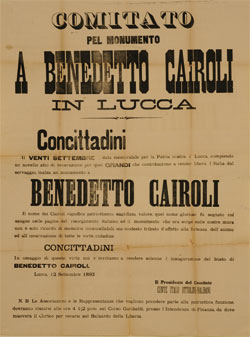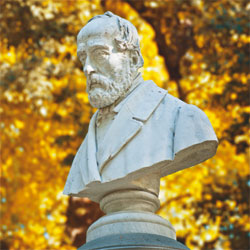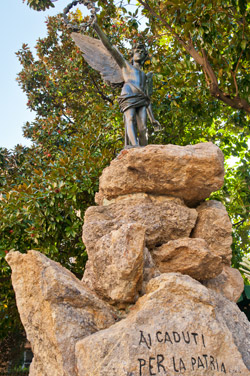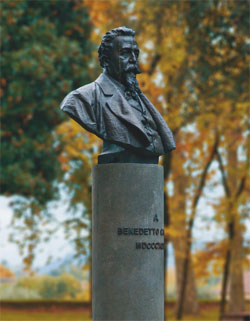Percorso tra i monumenti risorgimentali a Lucca
Roberto Pizzi
Fra i vari scultori impegnati nell'ambito della statuaria celebrativa della nostra città abbiamo scelto di mettere in evidenza Urbano Lucchesi, che più di altri sembrò identificarsi con lo spirito dell'epoca. A questo autore si debbono le statue di Giuseppe Garibaldi (1889), i busti di Giuseppe Mazzini (1890) e di Benedetto Cairoli (1893) e il monumento ai Caduti nelle patrie battaglie (1897). I monumenti risorgimentali all'interno della città sono tutti di Urbano Lucchesi; solo la statua di Vittorio Emanuele II sul baluardo di Santa Maria venne fusa in bronzo su modello di Augusto Passaglia e inaugurata nel 1885. Questi tre grandi Italiani rappresentavano per il giornale lucchese «l'idea che inspirò» (Mazzini), «il consiglio che diresse» (Vittorio Emanuele II), «l'azione eroica che attuò» (Garibaldi). Tutti e tre non dovevano «essere disgiunti dal cuore del vero patriota italiano». L'operazione sincretista, che si sarebbe sempre più diffusa in tutta la nazione con vari manifesti o ritratti di Mazzini, Garibaldi, Vittorio Emanuele II, e con l'aggiunta di Cavour, lo "statista", spesso raffigurati tutti e quattro insieme, era un'evidente forzatura che accomunava personaggi non omogenei tra loro, ognuno dei quali responsabile di un diverso progetto politico, ma rientrava nell'operazione di costruzione dell'edificio dello Stato nazionale, che, con tutti i suoi limiti e le sue carenze, era pur sempre la prima tappa fondamentale per l'inserimento dell'Italia nella civiltà moderna.
Il monumento a Garibaldi rinnova lo spirito anticlericale che nel 1863 aveva accompagnato l'erezione della statua del Burlamacchi . Anche l'iconografia scelta da Urbano Lucchesi per la raffigurazione dell'eroe aveva un chiaro sottinteso ideologico e si collegava con l'annuale celebrazione di Porta Pia: la statua raffigura infatti Garibaldi «nell'atto di porre il piede sul suolo romano e di rendere, a capo scoperto, omaggio a quella terra di eroi».
Il monumento di Giuseppe Mazzini, inaugurato il 16 marzo 1890, fu molto più modesto, dal punto di vista artistico (non certo simbolico), rispetto a quello di Garibaldi, per la scarsità dei mezzi finanziari reperiti e perché la raffigurazione di Mazzini risultava problematica. Per l'artista rappresentare l'eroe dei due mondi, uomo d'azione, era senza dubbio più agevole che immortalare Mazzini, un intellettuale, un politico, la cui arma era la penna.
Ancor più semplice di quello di Mazzini fu il monumento in onore di Benedetto Cairoli, costituito da un busto di bronzo sopra una bassa colonna che poggia sopra un plinto. Venne inaugurato il 20 settembre 1893, data ormai canonica degli anticlericali lucchesi, ma fin dall'inizio si scatenò una rumorosa contestazione ai danni del sindaco Enrico Del Carlo, l'antico sodale di Tito Strocchi divenuto artefice di un'ibrida alleanza tra la consorteria clericale e vecchi progressisti passati su posizioni apertamente moderate.
L'ultimo monumento civico di Urbano Lucchesi è dedicato ai Caduti delle Patrie Battaglie e in particolare alla data della presa di Roma, per la quale Antonio Mordini così si espresse: «data più bella del 20 Settembre la storia non ha». Dell'efficace allegoria del Genio alato che sovrasta l'imponente monumento ai Caduti delle patrie battaglie in piazza XX Settembre a Lucca, venne apprezzato in particolare il valore ideologico e politico: «quella figura che dall'alto della piramide grottesca, sormontata d'edera viva, protende il braccio destro in atto di porgere una corona votiva da collocarsi sull'ara che ricorda il memorabile avvenimento che suggellò nell'Urbe eterna l'Unità d'Italia e consacrò il trionfo della libertà contro il dispotismo teocratico e imperiale, è vigorosamente sentita; e se ne togli qualche durezza in alcune parti, può ritenersi indubbiamente una delle migliori sculture del nostro artista».
Journey through the Monuments of the Risorgimento in Lucca
Roberto Pizzi
Among the various sculptors specialising in celebrative statuary work in our town we have decided to focus on Urbano Lucchesi, who more than others seemed to identify himself with the spirit of the age. This sculptor gave us the statues of Giuseppe Garibaldi (1889), the busts of Giuseppe Mazzini (1890) and Benedetto Cairoli (1893) and the war memorial commemorating the Fallen in the Battles for the Fatherland (1897). The monuments of the Risorgimento inside the town are all by Urbano Lucchesi; only the statue of Vittorio Emanuele on the St. Maria rampart was cast in bronze, after the model of Augusto Passaglia, and inaugurated in 1885. These three great Italians represented for the Lucca daily newspaper «the idea which inspired» (Mazzini), «the council which directed» (Vittorio Emanuele II), «the heroic action which was put into effect» (Garibaldi). All three were not «to be disassociated from the heart of the true Italian patriot». The syncretic operation, which was to become increasingly more widespread throughout the entire nation, with various posters and portraits of Mazzini, Garibaldi and Vittorio Emanuele II, and with the addition of Cavour, the "statesman", all four often being represented together, was clearly a strained interpretation, associating figures with little in common, each in charge of a different political project, but this fell within the process of building the structure of the national State which, with all its limits and failings, was as ever the first fundamental stage towards placing Italy within modern civilisation.
The monument to Garibaldi renews the anticlerical spirit which had accompanied the installation of the statue of Burlamacchi in 1963. The iconography chosen by Urbano Lucchesi to represent the hero also had clear ideological implications and was linked to the annual celebration of Porta Pia: in fact the statue represents Garibaldi «in the act of stepping onto Roman soil and, bareheaded, rendering homage to that land of heroes».
The monument to Giuseppe Mazzini, inaugurated on 16 March 1890, was much more modest than the one to Garibaldi, due to the lack of funds raised and also because representing Mazzini proved to be problematical. For the artist, portraying the hero of the two worlds, a man of action, was without doubt easier than immortalising Mazzini, an intellectual, a politician, whose weapon was the pen.
Much simpler than the monument to Mazzini was that in honour of Benedetto Cairoli, consisting of a bronze bust above a low column resting on a plinth. This was inaugurated on 20 September 1893, by now a canonical date for anticlericals in Lucca, but right from the start this caused an outburst of loud protests against the mayor Enrico Del Carlo, the age-old associate of Tito Strocchi who had become the author of a mixed alliance between the clerical guild and old progressives which had passed over to openly moderate positions.
The last civic monument by Urbano Lucchesi dedicated to the Fallen in the Battles for the Fatherland and in particular to the date of the capture of Rome because, to use the words of Antonio Mordini, «history has no finer date than 20 September». The convincing allegory of the Winged Genius, rising above the imposing monument to the Fallen in the Battles for the Fatherland in piazza XX Settembre in Lucca, was particularly appreciated for its ideological and political value: «that figure which from the top of the grotesque pyramid, surmounted with live ivy, extends its right arm in the gesture of offering a votive crown to be placed on the altar, which recalls the memorable event which sealed the Unity of Italy in the Eternal City and consecrated the triumph of freedom over theocratic and imperial despotism, is felt with vigour and, if the harshness of some of its parts is removed, can without doubt be considered one of the best sculptures of our artist ».
 DOCUMENTI PDF
DOCUMENTI PDF
Percorso tra i monumenti risorgimentali a Lucca
I MONUMENTI

Manifesto per l'inaugurazione del monumento a Benedetto Cairoli, 12 settembre 1893. ASCLu, Scritture del protocollo generale, a. 1893 n. 7469.





